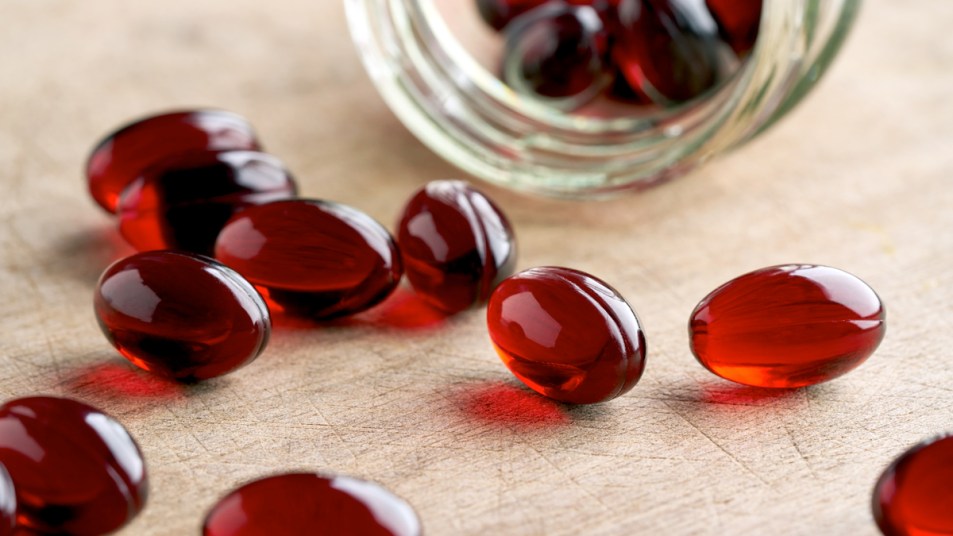This $12 Supplement Can Reduce Inflammation, Erase Wrinkles, and Boost Heart Health

What does whale food have to do with better heart health, reduced inflammation, and better skin? A whole lot, as it turns out. Krill oil, which is derived from the small crustacean near the bottom of the food chain, is a high-quality source of antioxidants and omega-3 fatty acids. Some health experts believe that it may be even more effective than fish oil in promoting healthy levels of omega-3s in the body.
The two most important forms of omega-3s, EPA (eicosapentaenoic acid) and DHA (docosahexaenoic acid), are found in both krill and fish. However, their chemical bindings differ. Krill oil typically contains EPA and DHA bound in phospholipids. Fish oil contains EPA and DHA bound in triglycerides. According to a 2015 study published in Lipids in Health and Disease, the phospholipid forms of EPA and DHA may be easier for the body to absorb.
For the study, researchers gave a small group of participants either krill oil, krill meal, or fish oil. They then measured the amounts of phospholipids and triglycerides in the participants’ blood plasma for 72 hours. Upon analyzing the data, scientists discovered that those who consumed krill oil had the highest amount of EPA and DHA in their plasma. Participants who consumed krill meal had the lowest amount of these two fatty acids in their bodies. This suggests that krill meal is the least effective in supplying the body with omega-3s.
Krill oil may improve heart health.
Other studies have shown that krill oil is linked to a healthier cardiovascular system, and in turn a healthier heart. The reason? It may reduce the levels of low-density lipoprotein (LDL) cholesterol and triglycerides in the body. For those who don’t know, LDL cholesterol is commonly referred to as “bad” cholesterol because it tends to sit on the inner walls of blood vessels.
As described in the paper published by the Journal of Hospital Pharmacy, one such trial set out to measure the effects of krill oil on patients with slightly high to very high cholesterol levels. Over the course of 12 weeks, participants received either a low dose of krill oil, a high dose of krill oil, fish oil, or a placebo pill (a fake, benign drug). Researchers discovered that total cholesterol decreased by 12 to 18 percent for all participants who took krill oil.
Better yet, LDL levels in all participants who consumed krill oil decreased by a whopping 32 to 39 percent. In comparison, the LDL levels in participants who consumed fish oil decreased by 5 percent. Participants who consumed the placebo pill experienced a 13 percent increase in LDL cholesterol. Scientists noted that more research is needed to confirm these findings.
Why might it be so effective at reducing LDL cholesterol in the body? Omega-3 fatty acids are known to lower triglyceride levels and increase high-density lipoprotein (HDL, or “good” cholesterol) in the circulatory system. In addition, krill oil contains astaxanthin, an antioxidant and a carotenoid that gives it a reddish color. Astaxanthin is particularly effective at reducing oxidative stress, which is caused by free radicals that damage tissues in the body. And in a trial published by the journal Molecules, researchers found this antioxidant to be a potential treatment for cardiovascular disease, especially atherosclerosis.
Krill oil may improve skin health.
Astaxanthin may also play a role in better skin health. The powerhouse nutrient is highly effective at lowering inflammation. It may have photoprotective properties as well, meaning it can combat the degenerative effects of sun damage.
As described in a 2018 paper published by the Nutrients journal, topical application of astaxanthin may help reduce the appearance of fine lines, wrinkles, and hyperpigmentation. A 2012 study published by Acta Biochimica Polonica also suggested that a daily oral supplement and topical treatment of the antioxidant can improve the skin’s texture and elasticity. According to the researchers, astaxanthin helped the skin retain moisture and kept the natural oil, sebum, in check.
In addition, krill oil contains vitamins A and E, which are known to promote cell regeneration and prevent sun damage, respectively. You may know vitamin A as retinol in skincare products, which can improve the appearance of aging skin by reducing fine wrinkles and smoothing the skin’s texture.
Who should take krill oil?
Krill oil is an excellent source of omega-3 fatty acids and important antioxidants. If you struggle to consume enough omega-3s on a regular basis, this supplement may be a great addition to your diet.
It may also be beneficial if you are looking to reduce your triglyceride levels. However, your physician may recommend a prescription omega-3 fatty acid medication instead. According to the American Heart Association, the FDA has approved this prescription for triglyceride levels above 500 mg/dL. It should also be noted that high doses of fish oil can cause bleeding, per Harvard Health. Fish oil supplements can also interact with medications such as:
- Warfarin (Coumadin).
- Clopidrogel (Plavix).
- Aspirin.
- Certain herbal supplements, such as St. John’s wort.
- Other nonsteroidal anti-inflammatory drugs.
Though not enough research has been done on the side effects of krill oil, experts at Harvard Health believe it may cause similar adverse reactions.
If you decide to take a krill oil supplement (Buy at Walmart, $11.88), remember that it should be paired with healthy lifestyle choices. The American Heart Association recommends that you also try to reduce triglyceride levels by exercising regularly, lowering your intake of sugar, simple carbs, and alcohol, and consuming healthy fats in place of saturated fats. Check with your physician to determine whether a supplement is best for you.
















